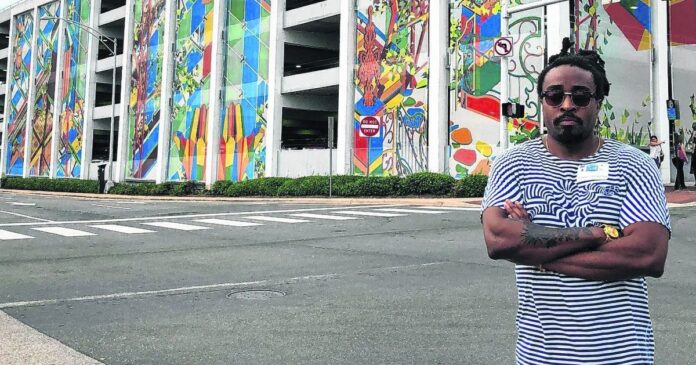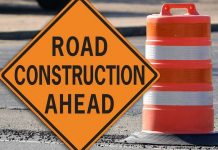
The designer whose Exhibit Columbus exhibition installation next summer will grace a prime spot at the Bartholomew County Public Library Plaza boasts a background of work reflecting painful American history, passionate and free expression and ethnic triumph.
Those realities surfaced in much of architect Olalekan Jeyifous’ presentation Thursday in the final installment of the virtual Exhibit Columbus symposium “New Middles: From Main Street to Megalopolis — What is the Future of the Middle City.” The presentation from next year’s Miller Prize winner was livestreamed before about 100 virtual viewers on the organization’s Facebook page and on Zoom.
The taped event will remain online and viewable with all the other symposium presentations since last month at exhibitcolumbus.org for some time.
The Exhibit Columbus program, launched in 2016, is an exploration of architecture, art, design, and community that highlights the city’s Modernist design legacy.
[sc:text-divider text-divider-title=”Story continues below gallery” ]
The Nigerian-born Jeyifous joined Whitney Amuchastegui, executive director of Su Casa Columbus and Carolina Castoreno-Santana, executive director of the American Indian Center of Indiana in a discussion that addressed how collaboration, alternative histories and more might play a role in the design of a community’s ethnically-inclusive future.
Jeyifous’ latest installation, installed in early March before the coronavirus shutdown, runs through November in Waterfront Park in the port city of Alexandria, West Virginia — a specific location that the designer discovered was once known for its heavy slave trade and the onetime home of one of the largest slave-trading firms in the nation.
The expansive work is titled “Wrought, Knit, Labors, Legacies.” It focuses on metal slave figures facing the water and its physical foundation also includes a colorful nod to black quilters of yesteryear.
“These characters do not reflect any one person, but more of a broad history,” Jeyifous said.
Amuchastegui complimented the architect for taking such a sensitive and explosive topic and presenting it “in a way that is educational and really is wonderful.”
She also praised the designer for taking personal stories “and placing them in the forefront of everyday reactions and interactions” such as runners sprinting past Jeyifous’ hard-to miss imagery.
Another one of his public, outdoor works has been “Protest” in Public Square in Cleveland, Ohio, featuring 12-foot-tall pieces representing protesting silhouettes, including someone speaking through a megaphone. The area is well-known as a sanctioned spot for demonstrations and the like. The work was installed in the summer of 2017, and a women’s march demonstration unfolded there shortly after that.
“I was really excited to see the artwork engage with the community,” the designer said. “People really sort of embraced it. And in a way, it was nice to see the artwork amplify the message of protests (there).”
Brightly colored, splashy, historic images that he labeled “a landscape collage” on nearly a full city block-long parking garage’s walls were part of his effort in 2018 in Durham, North Carolina. The isometric illustrations were part of a larger downtown revitalization project for downtown Durham. Input in the effort included the artist’s conversations with Durham’s senior set about the city’s civil rights movements of years ago, which clearly connects with an equitable future.
His eventual illustrations included a depiction of the city’s Merchants & Farmers Bank, a black-owned institution.
In Grand Rapids, Michigan, his “The Boom and the Bust” installation in 2019 reflected such significant issues of urban inequality as redlining, which involves denying of services — such as bank loans — to groups such as minorities, a practice that has prohibited their growth in some communities. That also ties in to the issue of an equitable future.
He discovered that some minorities in Grand Rapids were struggling with homelessness, and others were being forced out of homes to make way for booming commercial development.
“I wanted an installation that would investigate these two (extremes of boom and bust),” Jeyifous said.
[sc:pullout-title pullout-title=”Catch up on the symposium” ][sc:pullout-text-begin]
All presentations on the recently completed Exhibit Columbus symposium are available for viewing on the organization’s website at exhibitcolumbus.org
[sc:pullout-text-end]




